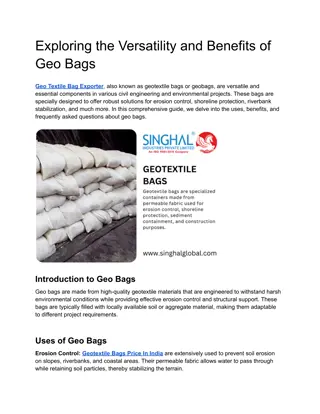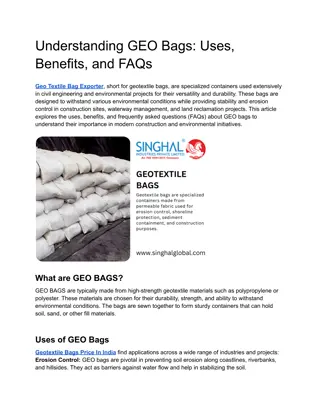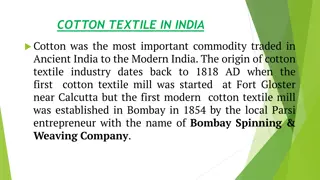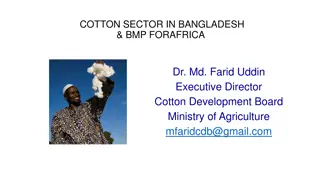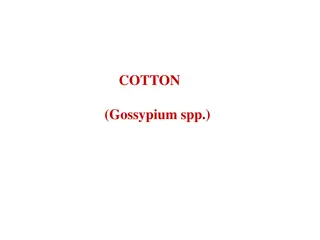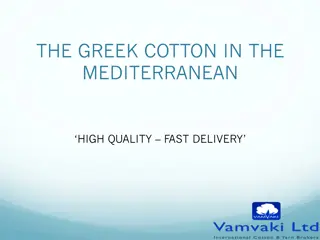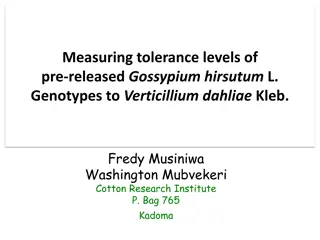Understanding the Production and Uses of Cotton in Textile and Pharmaceutical Industries
Raw cotton sourced from Gossypium herbaceum is processed to produce absorbent cotton for various applications. The purification process involves treatment with chemicals to remove fats and enhance absorbency. Cotton fibers undergo testing for identification. The resulting absorbent cotton is utilized in fabrics, surgical dressings, and pharmaceutical filter mediums due to its absorbent properties.
- Cotton production
- Textile industry
- Pharmaceutical applications
- Absorbent cotton
- Fabric manufacturing
Download Presentation

Please find below an Image/Link to download the presentation.
The content on the website is provided AS IS for your information and personal use only. It may not be sold, licensed, or shared on other websites without obtaining consent from the author. Download presentation by click this link. If you encounter any issues during the download, it is possible that the publisher has removed the file from their server.
E N D
Presentation Transcript
Plant Products Institute of Pharmacy, Vikram University, Ujjain
COTTON / RAW COTTON Synonym: Purified cotton. Biological Source: trichomes of seeds of cultivated species of gossypium herbaceum Family: Malvaceae Collection: The capsule of cotton consists of large number of seeds covered with trichomes, the trichomes are separated. Long trichomes are used in preparation of fabric & short ones are used in preparation of surgical dressings. This non absorbent cotton when treated with dilute soda solution for 10 to 15 hours at a higher pressure gets free of fats. The resulting absorbent cotton is dried, sterilized with gamma. Description: White, soft to touch.
Raw cotton discarded by the textile industry as combers waste consists of about 90% cellulose, 3% fat, wax and 7% moisture. This cotton is subjected to combing process so as to separate short fibres are spun and woven as cloth. The combers waste consisting mainly of short fibres is boiled with dilute caustic soda and soda ash solution for 10-15 hours at a pressure of 1-3 atmospheres. This treatment will remove fatty cuticle of the trichomes making the wall absorbent. Bleaching is done by treatment with sodium hypochlorite solution and dilute hydrochloric acid. It is washed with water and dried. This cotton is then carded into flat sheets. The carding machine forms thin continuous films of cotton wool.
Several such thin films are placed one above the other and packed into packages, which are finally sterilized. Ginning removes long hairs (better quality) Linter removes remaining short hairs Raw cotton has a waxy (fatty) cuticle covering the trichome Making it fairly non-absorbent Removed by soaking (or pressure heating) loosened cotton in alkali (NaOH, KOH) To get absorbent cotton (trichome wall is absorbent) Then washed, bleached and mechanically loosened scutched
Chemical Tests Absorbent Cotton Fiber when treated with N/50 iodine solution & 80% H2SO4 gives a blue stain Fiber when treated with cuoxam reagent, swells & dissolves Fiber gives a blue stain with chlor-zinc-iodide Non Absorbent Cotton Fibre when treated with cuoxam reagent, swells & dissolves with ballooning Fibre gives a violet stain with chlorzinc iodide Uses: Fabrics, surgical dressings, Pharmaceutical filter medium
JUTE Biological Source: obtained from phloem fibers of Corchorus capsularis Family: Tiliaceae Description: Brown, rough to touch Fibres separated -- hesisan and sacking Remaining short fibres tow -- jute in pharmacy Cultivation Process Sowing of jute starts with the showers in March or April and continues till early June. Phosphorus, Potash & Nitrogen fertilizers are used for this crop.
Harvesting Process Jute is harvested any time between 120 days to 150 days when the flowers have been shed, early harvesting gives good healthy fibers. . The harvested plants are left in the field for 3 days for the leaves to shed (means leaves got dried up). Retting Process Retting is a process in which fibers get loosened due to decomposition of hard cell walls by the action of bacteria. The bundles are steeped in water at least 60cm to 90cm depth. Stripping Process (Fiber Extraction) Stripping is the process of removing the fibers from the stalk after the completion of retting. Fibers are removed from the stalk by any one of the following methods: 1. Single plants are taken and their fibers are taken off. 2. Taken off a handful of stalks, breaking it in a to and fro motion in water.
Washing Process Extracted fibers are washed in clean water. The dark color of fibers can be removed by dipping them in tamarind water for 15 to 20 minutes and again washed in clean water Drying Process The fibers are hung on bamboo railings for sun drying for 2-3 days. After drying, the fibers are ready to be sold in the market. Identification of jute fiber Feeling test: Stiff and a harsh hand to human skin, feels bad against skin. Burning test: Not melt, burn easily, smell like paper burning, because paper is also a cellulosic material. Microscopic identification: Polygonal shaped cross-section and many ultimate cell of longitudinal view identified jute fiber. Solubility: Jute is dissolved by H2SO4. Staining: To study the morphology of fiber surface.
Chemical Test: Fibre when stained with phloroglucinol & HCl gives a deep red colour Fibre gives a yellow stain with chlorzinc iodide Uses: Jute is cheap and reasonably strong and is available in large quantities. Generally used in: Sacks & Packing Cloth Food Storage Backing cloth for carpets Curtains & Furnishing fabric Used in Geotextiles, technical textiles and textile composites Mixed with wool, used in cheap clothing
HEMP Synonym : Cannabis, Hashish, Bhang, Ganja, Charas, Marihuana Biological source : dried flowering tops of cultivated female plants of Cannabis sativa Family : Cannabinaceae Geographical source : Mexico, Africa, India (MH, WB, MP) Color: dull green Odour: Strong, characteristic and narcotic Taste: acrid and pungent Narcotic production: Only female plants are selected because the resinous material is only found in the same
Cultivation Cultivation only by license from Govt. Soil: light loamy or sandy Climate: Humid, tropical Propagation: Seed Kharif crop, cultivation : June-July Distance: 1 meter between 2 rows Requirement: 6-9 kg seeds per hectre Flowering season: Dec-Jan Average ganja yield: 275 kg
Narcotic products from Hemp: Bhang or hashis, Ganja,Charas Bhang or Siddhi Cutting the leaves and flowering tops of the plant, exposing them to sun and dew, drying and pressing the drug. The product is stored in earthenware vessels. The resinous matter present in glandular trichomes containing hallucinogenic matter. Unfit for medicinal use owing to deficiency of resin. Taken in form of an electuary made by digestion with melted butter (medicine composed of powders, or other ingredients, incorporated with some conserve, honey, or syrup)
Ganja It consists of dried flowering or fruiting tops of the female plants from which no resin has been removed It is collected only from cultivated plants Plants are collected when the lower leaves fall on the ground and flower stalks begin to turn yellow. The floral shoots are cut off and are spread out in ridges and furrows. The ridges are levelled down and crushed to press the floral shoots into compact sheaves The turning of the material is done at regular intervals. After that, material is collected and arranged in flat heap
It is then subjected to pressure under the press The heaps are turned over and broken up, so as to form thick layers After 3-4 days, ganja is ready for storage Two types of ganja are available in the market The flat ganja, the individual pieces of the plants are pressed by thresing, wherein the resinous material of the flowering tops sticks together to form the flat mass. The flat ganja coming from Ahmednagar district Maharashtra is well known in commerce. Round ganja is regarded as better quality where the resin free parts of the plant are removed and every piece (flowering top) is rolled individually, so as to form cylindrical mass. It is prepared in bengal.
Charas It is resinous exudation collected from the leaves of the hemp plants. The resinous secretion, appearing just before flowering of the plant, is collected by rubbing the fresh tops between hands or by beating them on cloth or carpet. The adhering material is scrapped off to yield, charas of thee market. It is collected even by walking through the cultivated plants after wearing the leather aprons. The resinous secretion, which sticks to the leather apron is scrapped off and collected.
Chemical Constituents 15-20% Resin (present in glandular trichomes) Major constituent: 1-3-4 trans tetra-hydrocannabinol (THC) Volatile oil, trigonelline, choline, Seeds-20% fixed oil Resin: Cannabinol, cannabidiol, cannabidiolic acid, cannabichromene, cannabigerol Uses: Narcotic, Sedative, Analgesic Psychotropic properties due to THC (tetrahydrocannabinol) At present, very little used as a drug Cause intoxication, euphoria and later mental disturbances. Storage : Should be stored in well closed container after thorough drying
Identification test : 1. Shake 0.1 g drug + 5ml light petroleum (60-80 degree C) and filer. To 1ml filtrate + 2ml 15% solution of hydrogen chloride in Ethyl alcohol. At the junction of 2 liquids, a red coloration appears. After shaking, upper layer becomes colorless and lower layers acquires pink color which disappears on addition of water. 2. Extract 1g of resin with methanol, filter and evaporate to complete dryness. Again extract the resulting residue with petroleum ether (60- 80 C), filter directly into a separating funnel and extract the ethereal layer successively with 5% (w/v) Na2CO3 and 5% (w/w) H2SO4. Wash the ethereal layer with distilled water, decolourise with powdered activated carbon, if necessary, and evaporate the filtrate. Add to the residue a few drops of N/10 alcoholic KOH solution, when a purple colouration is obtained.
Reference : 1. C. K. Kokate , A.P. Purohit , S. B. Gokhale Pharmacognosy, 41st edition May 2008, page no 10. 29 & 11.113 to 11.116 Nirali prakashan 2. https://www.britannica.com/plant/jute-plant




